Surrealism
What is surrealism?
Surrealism is an artistic and literary movement that emerged in the 1920s, focusing on the irrational, dreamlike, and subconscious mind. It sought to break free from logic and realism, creating art that explored fantasy, dreams, and unexpected juxtapositions.
What are the different types of surrealism?
Dreamlike Imagery, inspired by Sigmund Freud’s theories of the unconscious, surrealist works often resemble hallucinations or dreams.
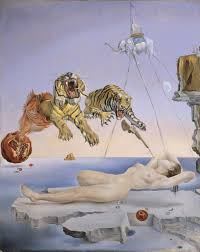
Unexpected Juxtapositions, artists combine unrelated objects or concepts in strange, thought-provoking ways.
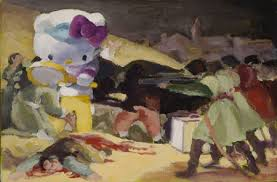
Automatism, a method where artists and writers create spontaneously, without conscious thought, to tap into the subconscious.
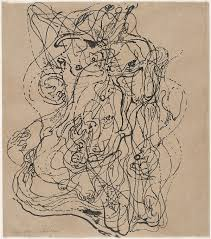
Irrationality & Absurdity, surrealism challenges logic and reason, embracing the bizarre and nonsensical.

Symbolism & Metaphor, objects often hold hidden meanings, reflecting deep psychological themes.
Conclusion of surrealism
Surrealism aims to revolutionise human experience. It balances a rational vision of life with one that asserts the power of the unconscious and dreams. The movement’s artists find magic and strange beauty in the unexpected and the uncanny, the disregarded and the unconventional.
Artist Reference
Man Ray
Who is he?

Man Ray was an American visual artist who spent most of his career in Paris. He was a significant contributor to the Dada and Surrealist movements, although his ties to each were informal. He produced major works in a variety of media but considered himself a painter above all.
What are the Dada and Surrealist movements?

Infamously called the “anti-art” art movement, Dadaism developed out of disgust and resentment from the bloodshed and horror of World War I, which began in 1914 and ended in 1918. Dadaism’s main purpose was to challenge the social norms of society, and purposefully make art that would shock, confuse, or outrage people.
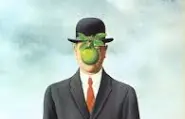
Surrealism is an art and cultural movement that developed in Europe in the aftermath of World War I in which artists aimed to allow the unconscious mind to express itself, often resulting in the depiction of illogical or dreamlike scenes and ideas.
Conclusion of his work
Man Ray’s career is distinctive above all for the success he achieved in both the United States and Europe. First maturing in the center of American modernism in the 1910s, he made Paris his home in the 1920s and 1930s, and in the 1940s he crossed the Atlantic once again, spending periods in New York and Hollywood. His art spanned painting, sculpture, film, prints and poetry, and in his long career he worked in styles influenced by Cubism, Futurism, Dada and Surrealism. He also successfully navigated the worlds of commercial and fine art, and came to be a sought-after fashion photographer. He is perhaps most remembered for his photographs of the inter-war years, in particular the camera-less pictures he called ‘Rayographs’, but he always regarded himself first and foremost as a painter.
Image analysis/focus
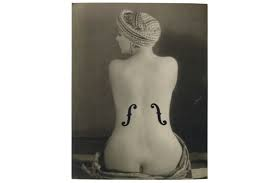
The subject and composition can be analysed as a nude woman with the suggestive silhouette and a violin in the shade of her back. The woman’s form is sculptural, where her human body is merely reduced to a form of a canvas which depicted woman as idealized forms. The violins shape is drawn in chalk like lines, which echoes his own studies of the human body. Integrating the elements of classical art with a dream like surrealist twist. The violin is an impotent symbol in his work, it alludes to the idea of an artists secondary passion or hobby. Ingres was known to be am accomplished violinist in addition to his work as a painter/photographer. Man Ray cleverly uses the violin as both a literally and symbolic device within the photo, offering a playful suggestion that the female body itself could be used as a musical instrument as well as an artwork. Some key surrealist elements are portrayed, as surrealist were fascinated by the juxtaposition of seemingly unrelatable objects. By placing the violin the image disrupts but also draws attention to the sexualised nature of the female form. The use of the violin is a playful distortion of familiar artists motifs, adding an element of absurdity. The lighting is also key to enhancing the from of the by rendering the violin as something almost unattainable , as if it is a abstraction. This brings attention to the objectification of the female form, using the instrument as a metaphor for desire. The models pose is reminiscent of the classical depictions of the female nude, whilst the violin makes it odd, almost unsettling. This ties into the early 20th century critiques of traditional arts treatment of woman as objects for male pleasure. The high contrast lighting emphasised the figure of the model, creating sharper shadow’s that accentuate the body’s form while drawing the viewers eye to the very exaggerated shape of the violin. The use of light here is reminiscent of Man Ray’s ,artery of experimental photography. Notably his famous use of rayographs and other methods that have explored shadow, texture and form. When this image was created in 1924 the surrealist movement was at its peak, pushing boundaries in both visual art and photography. Man Ray who was a prominent figure in the movement, experimented with both fine art and fashion photography, creating works that blurred the lines between the real and the imagined much like the surrealists approach to art and physiology.
In summary, Le Violon d’Ingres is a masterful blend of playful surrealism, art historical reference, and subversive critique of femininity, objectification, and classical art. It invites the viewer to reflect on the tension between the human form and the arbitrary imposition of artistic and sexual symbols. Through its light, composition, and humour, the photograph remains one of the most significant works in the history of 20th-century photography.
How does this connect to surrealism?
Ingres, whose name appears in the title of Man Ray’s photograph, was a leading figure of Neoclassicism, an art movement that can be seen as a continuation of the humanist tradition, where the human body was viewed as an ideal form to be studied and revered. In Le Violon d’Ingres, the model’s body is positioned in a similar way to Ingres’ classical nudes, suggesting a connection to this idealized human form.
The photograph emphasizes the human body, particularly through its curves, light, and shadows. This focus on the body itself evokes a humanistic tradition that places the human figure at the centre of artistic contemplation. However, the surreal manipulation of the figure with the violin inserted onto the model’s back introduces a surrealist twist to this tradition, creating both a nod to humanism and a challenge to its conventions. This tension between the classical ideal and the distortion of that ideal reflects a key theme of the early 20th century, when humanism was being re-examined, especially in light of modernity, industrialization, and the upheavals of war.
Hoe does this connect to union?
The most direct way the photograph connects to the idea of union is through the fusion of the human body with artistic representation. The model’s nude body, traditionally the subject of visual art, is combined with the violin, which is an instrument often used to create music, an entirely different form of art. This union of two distinct forms of art—visual and musical—creates a deeper connection between the body and the creative expression. The body itself becomes a medium through which both visual art (the photographic representation) and music (symbolized by the violin) are explored.
Man Ray’s photograph brings together two distinct artistic worlds: classical and surrealist. Ingres, the painter referenced by the title, was a master of classical art and Neoclassicism, which emphasizes idealized, often sensual depictions of the human body. Man Ray’s photograph invokes this classical aesthetic with the smooth, curvaceous form of the nude woman. However, by replacing her back with a violin, he injects a surreal, playful element that distorts this classical vision, bringing a modern, irrational twist to an otherwise conventional subject. This union of the classical with the surrealist approach reflects the way modern artists of the 20th century were blending historical traditions with experimental, avant-garde methods.
- How to Incorporate:
- Union Between Real and Imagined: Explore surreal or abstract depictions of unity. This could mean photographing individuals or objects that merge together in strange ways (e.g., using double exposure, juxtaposing dreamscapes with real scenes, or creating imaginary unions between people or elements in unexpected settings).
